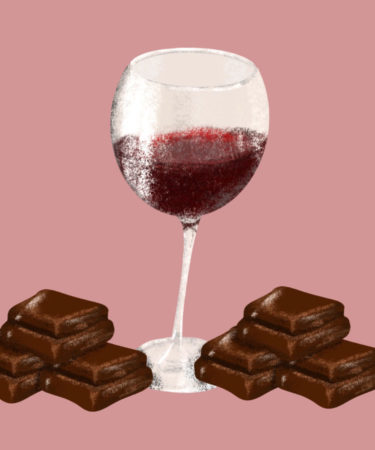Wine and chocolate, two indulgences equally delicious on their own, can be a disaster when paired together. But for those looking to get adventurous with wine and chocolate, there are ways to make it work.
While working with Belgian chocolatier Neuhaus to curate pairings for its new Wine & Praline Collection, Sarah Thomas, advanced sommelier and co-founder of Kalamata’s Kitchen (and formerly of Le Bernardin), found she had to shed some of her own preconceived notions, one of which was that it is “nearly impossible to make a dry wine really pair with sweets,” she tells VinePair.
Neuhaus made six varieties of pralines to be specifically paired with drier wines; half suitable for red wines, and the other three to be matched with whites. Additionally, each confection trifecta was to be paired with either a classic, or more “adventurous” bottle.
After coming to terms with the fact that sweet wines were off the table, Thomas learned to embrace the pralines’ unorthodox tastes. She discovered they were “lower in cocoa-tannic intensity, and also [had] more savory, herbal, and salty characteristics than traditionally sweet pralines,” she says. What once seemed like an impossible task began to appear more feasible.
The trick was approaching the chocolate treats in the same way she would a fully composed dish: by identifying the unique components of each piece. She then created a list of wines and enlisted the palates of her sommelier friends to help with taste testing.
Concerned about competing tannins and astringency, the three pralines designed for red wines initially caused Thomas the most concern. As it turned out, the “Safran,” filled with white chocolate ganache and blackberry, saffron, and rosemary-honey flavors, paired nicely with a full, fruity Shiraz and a spicy, bright Zinfandel.
For the “Amandes” praline, the salt, nuttiness, and olive oil flavors sang with a rich, buttery Chardonnay. Thomas credits this as a classic “fat meets fat” pairing — it worked because it highlighted the brioche and creamy flavors in both.
Her favorite pairing? The “Cerises,” a ganache-based praline with cherries and a cassis-cocoa butter finish, paired with a rich, oxidative Spanish Monastrell that helped to illuminate the cherry flavors.
Thomas offered the following three tips for pairing wine with more traditional desserts:
1. Pair sweet with sweet.
Chocolate actually shares many characteristics with wine, such as acid, tannins, and sugar, that can make pairings complicated. Thomas suggests that the wine you are pairing should be as sweet or sweeter than the dessert. If the wine is drier than the dessert, it may likely cause the wine to taste sour.
2. If you want to go dry, avoid intensity.
If you really hate sweet wine and must go with something dry, Thomas suggests looking for a wine that has a rich fruit quality and isn’t heavily tannic or too acidic. Both the tannins and acidity will scrape the fat and sweetness of the dessert from your palate.
3. Find a balance.
When pairing food and wine, the goal is always to seek a balance of structural and flavor elements of the dish and drink. Every pairing is about “bringing together two individually delicious creations to create one whole enhanced experience,” Thomas says.
Of course, at the end of the day, it’s really about your own tastes and preferences.
